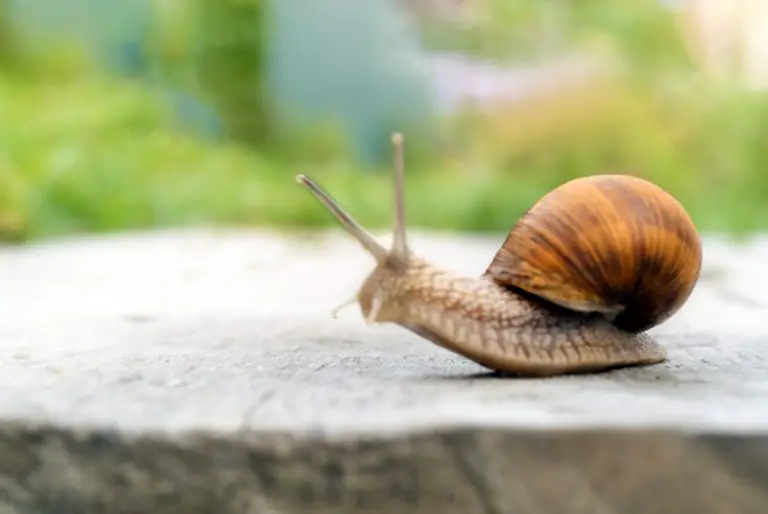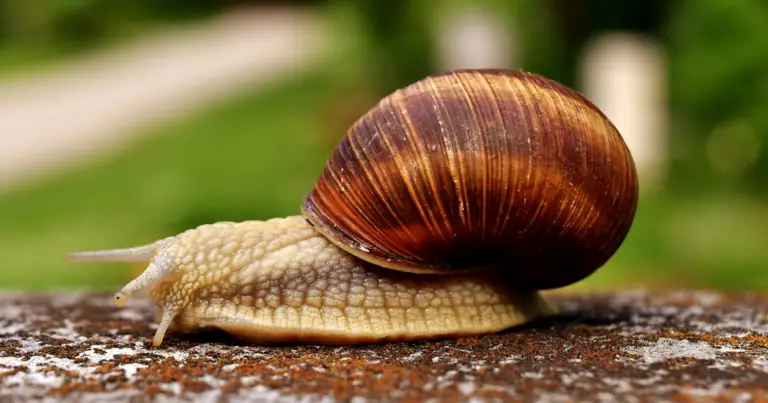What Do Mystery Snails Eggs Look Like?

Mystery snails are a popular addition to freshwater aquariums due to their hardiness, easy care, and ability to help keep the tank clean by scavenging for plant matter. As a mystery snail owner, you may wonder, “What Do Mystery Snails Eggs Look Like?”
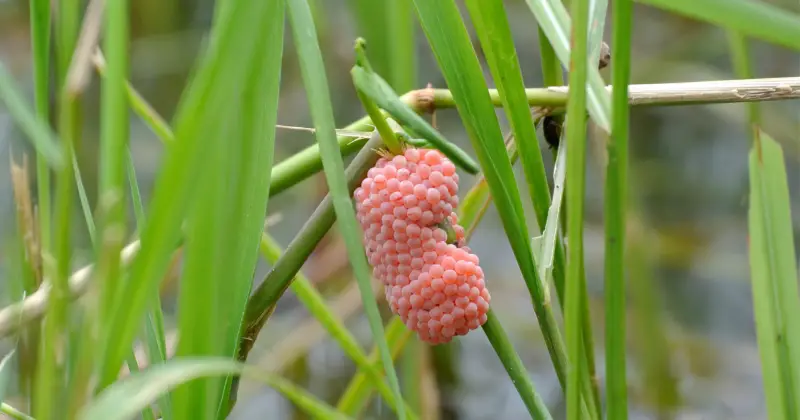
Mystery snail eggs resemble small, round jelly-like globules, which can vary in color from white to brownish-gray. Female mystery snails typically lay their eggs on the glass walls of the aquarium in clusters of four or six. These eggs will display a tiny black spot in the middle if fertilized, indicating a developing snail inside. The eggs will also take on a larger, fuller appearance with more irregular shaping as they continue to develop.
Understanding the appearance and care of mystery snail eggs is crucial for ensuring a healthy environment for your snails to thrive. Monitoring the eggs closely and knowing what to expect during their development will enable you to raise happy and healthy mystery snails in your aquarium successfully.
Contents
Table of Contents
Understanding Mystery Snails

Mystery snails are a popular freshwater snail species commonly found in the aquarium hobby. These fascinating mollusks originate from South America, particularly in countries like Brazil and Paraguay. You might often come across them in freshwater and brackish habitats, where they have adapted well to their environment.
As an aquarium enthusiast, you should know that there are several species of mystery snails, each with their unique behavior and appearance. One striking feature of these snails is their peaceful temperament, which allows them to coexist with other aquatic creatures in your aquarium without causing disruptions.
When it comes to the habitat requirements for mystery snails, you’ll find that they thrive in well-maintained environments. Providing a clean freshwater tank with stable water parameters, hiding spots, and appropriate tank mates will ensure your snails lead a healthy and happy life.
Mystery snails belong to the Ampullaria family, encompassing all apple snail species. Knowing your mystery snails’ care requirements is crucial as a responsible aquarium owner. This will ensure that your aquatic pets stay healthy, and active, and can potentially reproduce, allowing you to marvel at their fascinating life cycle.
In conclusion, mystery snails are an intriguing addition to your aquarium, offering visual and ecological benefits. By understanding their origins, behavior, and care needs, you can provide a suitable environment for them to flourish and contribute positively to your aquarium’s overall health.
Mystery Snail Eggs Overview
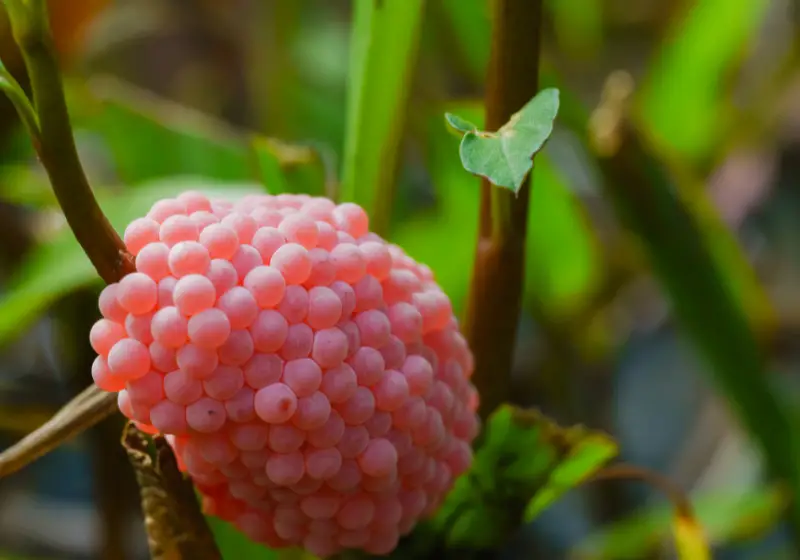
As a mystery snail owner, you might be curious about your snail’s reproductive habits, particularly regarding their eggs. Mystery snail eggs are typically found in a clutch, a cluster of eggs. They have a unique appearance, and it is essential to understand how to identify and care for them.
Mystery snail eggs come in various colors, including yellow, pink, or white. The eggs will appear like small balls packed in a sack that looks like clusters of shotgun shells, making it easy to spot them in your aquarium. The clutch size may vary, but each clutch usually contains about 20 to 40 eggs. The female mystery snail will usually lay her egg clutches on the glass walls of your aquarium in clusters of four or six.
You must maintain the water conditions in your tank to ensure your snail eggs develop properly. The temperature should fall between 68 to 84°F, and the pH must be above 7.0 to prevent shell damage. Aim for water hardness between 12 to 18 dGH and a pH range of 7.5 to 8.5 for the right environment, as the Everything Fishkeeping website suggested.
Regarding fertility, it is crucial to know that not all mystery snail egg clutches will be fertile. Infertile clutches or unfertilized eggs can occur if the female snail has not mated with a male or if the breeding conditions were not met. If you notice that the eggs do not develop or hatch after a few weeks, they are likely infertile.
Paying attention to your mystery snails and their eggs can create the best environment for their growth and development, resulting in a thriving, well-maintained aquarium.
Conditions Necessary for Breeding

Breeding mystery snails successfully requires providing the right environmental conditions in their tank. Here, we will discuss the key factors you should consider to create optimal breeding conditions, including tank size, water parameters, and temperature.
First, ensure your snails have enough space to move around and mate. A minimum tank size of 10 gallons is recommended when housing several mystery snails. It might be wise to set up a separate breeding tank or a breeder box to isolate the mating snails from the other aquatic life in your aquarium and allow them a stress-free environment for breeding.
Next, water hardness is essential since it directly impacts snail shell health and growth. The ideal water hardness levels for mystery snails range from 3 to 18 dKH. Inadequate water hardness may result in weak shells and difficulty maintaining calcium levels.
Temperature is another important element in setting up a successful snail breeding environment. Maintain a steady water temperature between 68 and 82°F (20 and 28°C) to ensure your snails are comfortable and comfortable to mate. Sudden fluctuations in temperature may cause stress to your mystery snails, impacting the breeding process negatively.
Lastly, it’s crucial to maintain proper water conditions, such as providing adequate filtration and oxygenation. Good water quality encourages healthy snails that are more likely to breed and reproduce. Regular water changes and proper tank maintenance are essential in keeping the water clean and the snails in good health.
You will most likely achieve successful mating and breeding by considering these factors and providing the appropriate environment for your mystery snails. Monitor the parameters closely to ensure the conditions remain optimal throughout the breeding process.
Hatching Process of Mystery Snail Eggs

When it comes to hatching mystery snail eggs, there are some key factors to consider for a successful process. You should pay close attention to temperature, humidity, and the developmental stages of the eggs.
First and foremost, the water temperature is essential for developing and hatching mystery snail eggs. Maintaining a consistent water temperature between 68-84°F (20-29°C) is recommended for optimal breeding and hatching conditions. You can use a reliable aquarium heater to help maintain these conditions in your fish tank.
Now, let’s talk about the humidity levels. To ensure the eggs do not dry out, it is important to maintain proper humidity levels around the clutch. You can use an aquarium heater or a mister to help create the ideal environment. Condensation forming on the aquarium walls and lid indicates that you provide adequate humidity for the eggs.
During the hatching process, you will observe several stages of development. As the eggs are initially laid, they will appear pale pink and soft to the touch. Over the next week, the eggs will harden and darken in color, becoming a garnet brown. After two weeks, the eggs will become slimy and appear dark grey, signaling they are ready to hatch.
As the eggs hatch, tiny baby snails emerge and reach the water surface. It is a good idea to have a siphon or a net handy to assist in transferring the baby snails to a separate tank or breeding area. This will help protect the babies from potential predators in the main tank.
During the first few weeks of their lives, the baby snails will experience rapid growth. Proper care and nutrition are essential for their further development and well-being. You can use high-quality snail food to ensure the babies receive the nutrients they need to grow.
In conclusion, maintaining the proper water temperature, humidity, and environment, in combination with diligent observation and care, will help ensure a successful hatching process for your mystery snail eggs.
Dietary Requirements and Anatomy of Mystery Snails

When keeping Mystery Snails in your aquarium, it’s crucial to understand their dietary requirements and unique anatomy. Mystery Snails, scientifically known as Pomacea Brigesii, are herbivores and play an important role in keeping your aquarium clean by consuming algae and leftover food. Their diet should be well-rounded, including vegetables and calcium supplements for shell growth and maintenance.
Mystery Snails have an interesting anatomy that allows them to thrive in their aquatic environment. Like other apple snails, they possess a large muscular foot that helps them move through the tank. The foot is covered in tiny structures called gills that filter oxygen from the water, enabling them to breathe underwater.
Acquainting yourself with their anatomy is essential in understanding their behavior and care. For instance, the tentacles on their face help them detect food and potential dangers. Additionally, Mystery Snails have a siphon or snorkel-like tube that they use to breathe air from the surface when the water conditions are less favorable.
It’s important to note that these fascinating creatures come in various colors, such as gold, white, and blue, adding diversity to your aquarium. Ensuring that their dietary and care requirements are met will provide an environment for your Mystery Snails to coexist with other aquatic species, making for a healthy and vibrant underwater ecosystem.
Various Colors and Species of Mystery Snails
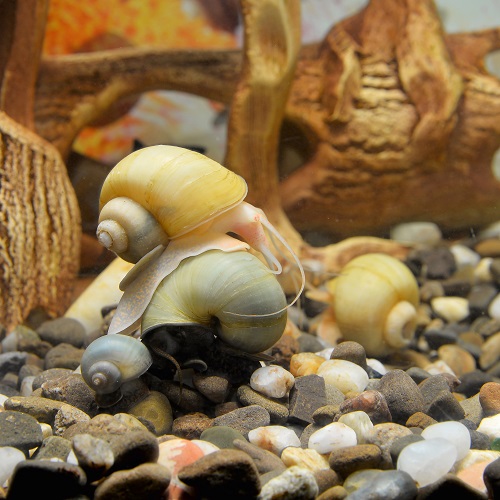
Mystery snails, also known as Pomacea bridgesii, come in an outstanding variety of colors and combinations, making them a fascinating addition to your aquarium. In this section, we will be focusing on the most common shell, body, and stripe colors that you can find among these captivating creatures.
Your mystery snails can have shell colors ranging from yellow, green, and purple to white (ivory) source. These colors often serve as the base for their overall appearance. Combining at least two primary pigments contributes to this assortment of colors. For example, a mystery snail may have a yellow base pigment and a brown or reddish-brown pigment.
Even more color variations are possible regarding the body color of these snails. With options like brown, gold, blue, black, magenta, purple, olive, and more, you will find that your snails can be quite the display of hues.
It’s worth noting that the coloration and patterns on mystery snails’ bodies and shells do not necessarily indicate the specific species. However, differentiating between species might be helpful when considering their potential for becoming invasive.
Pomacea bridgesii are not considered invasive species, unlike others, such as Pomacea canaliculata. This is important to remember, especially if you plan to keep mystery snails in an outdoor pond.
In summary, when it comes to mystery snails, their shell and body colors are versatile and mesmerizing. The numerous color variations make them an exciting choice for your aquarium, while their non-invasive nature ensures they won’t pose undue harm to the environment.
Aquarium Maintenance for Mystery Snails
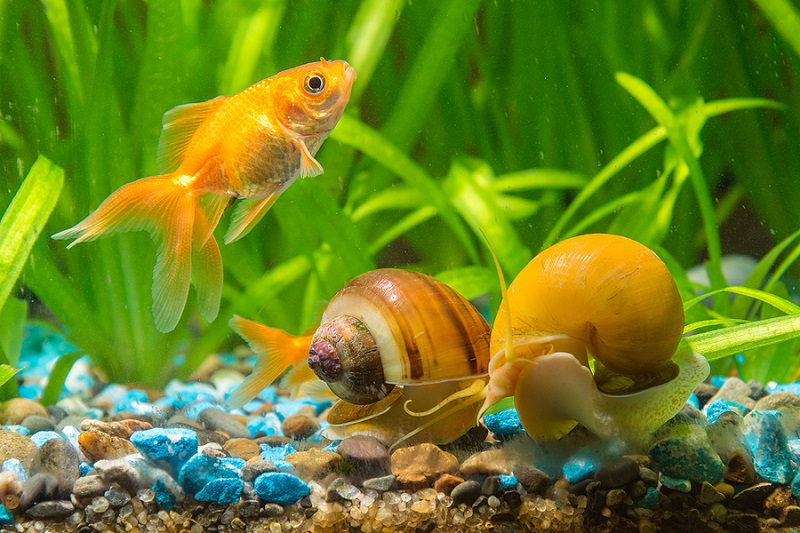
To ensure the well-being of your mystery snails, it is essential to keep your aquarium clean and maintain the appropriate water parameters. Start by regularly monitoring your aquarium water to keep ammonia levels under control. Ammonia is toxic to aquatic life; even a slight increase in its concentration can harm your snails.
Mystery snails thrive in a community tank environment with a pH between 7 and 8. To maintain the ideal water parameters, frequently test the aquarium water, making adjustments as needed. Additionally, maintain a consistent water temperature between 68 and 84°F for your snails’ comfort and health.
Keep an eye on the water level in your aquarium, as mystery snails need access to the water surface to breathe. Ensuring enough air space above the water will help provide sufficient oxygen for your snails.
Cleaning your aquarium regularly is essential to minimize waste buildup and maintain proper water conditions. Perform a partial water change every two weeks by removing about 25% of the tank’s water and replacing it with new, dechlorinated water. This regular maintenance will help to prevent algae growth and the buildup of waste, contributing to the overall health of your aquarium snails.
In a community tank, it’s important to choose tank mates that are compatible with mystery snails. Ideal tank mates include peaceful fish species and other non-aggressive snails. Avoid placing aggressive or predatory fish species in your aquarium, as they can harm the snails and disrupt the harmony of the tank environment.
Lastly, provide a variety of hiding spaces using plants, driftwood, or river rocks to create a comfortable habitat for your mystery snails. This mimics their natural environment, offering both refuge and ample foraging opportunities for your snails while also enhancing the overall aesthetic appeal of your aquarium.
Mystery Snail Care and Breeding: Your Friendly Neighborhood Algae Eater!
Dealing with Mystery Snail Eggs
Mystery snail eggs can be identified by their pale pink color in the first 24 to 48 hours, and they eventually darken and become garnet brown over the next few weeks. You must ensure proper care and control their reproduction to deal with them.
Firstly, keep an eye on the eggs’ development. Fertile eggs will have a tiny black spot in the middle, indicating a developing snail. This can help you determine whether the eggs might hatch or not. If your snail eggs aren’t developing after two weeks, it could be due to a lack of a male snail for reproduction. Remember that mystery snails cannot reproduce asexually.
To dispose of unwanted or infertile mystery snail eggs, gently remove them from the tank or any clinging surface they’re attached to. For a definitive way to check if the eggs are infertile, place them on a towel. If they leave a stain, they are considered infertile.
When it comes to disposal, you have several options. One method is placing the eggs in a freezer for a few hours to ensure they won’t hatch if they’re already outside the aquarium. After freezing, you can throw them away. Additionally, if you don’t want your snails to reproduce, controlling the population in your aquarium is essential. This can be done by removing the male snails or separating them from the females.
Lastly, maintaining adequate moisture levels in your snail habitat greatly influences egg development. Keep the water temperature between 75 and 80 degrees Fahrenheit, with a pH of 7.5 to 8 and a hardness between 8-13 dGH for optimal growth and development.
By following this advice, you can effectively deal with mystery snail eggs in your aquarium. This will ensure a manageable snail population and a healthy environment for your aquatic pets.
Predators and Lifespan of Mystery Snails
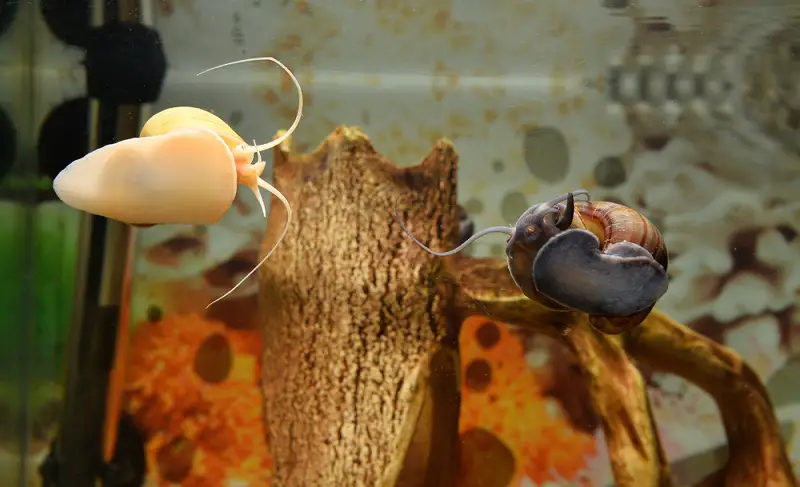
Mystery snails are unique and fascinating, making them popular in freshwater aquariums worldwide. As you raise these snails in your tank, you might wonder about their natural predators and how long they typically live.
In the wild, mystery snails face various predators. Some common ones include fish, birds, and even other snails. It’s essential to be aware of these risks when setting up an aquarium, ensuring a safe and suitable environment for your snails to thrive away from their natural predators.
Regarding their lifespan, mystery snails generally live for about 1-2 years. However, the lifespan might vary depending on water quality, diet, and living conditions. Always maintain appropriate water parameters to maximize the health and longevity of your mystery snails.
The water pH should be between 7.6 and 8.4, and water hardness should be 12 to 18 kH. Maintaining well-oxygenated water with a moderate flow is vital to ensure a healthy environment for your snails. Additionally, be cautious about the presence of copper in the water, as mystery snails are sensitive to it1.
By being familiar with their predators and properly caring for their living conditions, you can ensure your mystery snails lead a healthy life in your aquarium, contributing to a lovely and balanced ecosystem.
The Impact of Invasive Mystery Snails

Invasive species like the banded and Chinese mystery snail can significantly impact freshwater ecosystems. These snails can disrupt the aquatic food chain, increase the mortality rate of fish eggs, and even transmit diseases and parasites to fish and other wildlife.
By knowing what mystery snail eggs look like, you can take measures to prevent their eggs from hatching in your grow-out tank or freshwater aquarium. Typically, these eggs appear as pink clumps when they are first laid. They will begin to darken and vary in size after 48 hours. To monitor their development, you can place the eggs on a damp paper towel, providing a suitable environment for them to mature.
As these snails consume detritus and compete with native snails for food, they can disrupt the balance of your freshwater ecosystem. In addition, banded mystery snails may invade largemouth bass nests, increasing the mortality rate of their eggs.
Preventing the introduction of invasive mystery snails into your tank or aquarium not only protects the native species within the ecosystem but also helps maintain overall water quality. If you suspect that mystery snail eggs have been introduced into your tank, promptly remove them and take steps to ensure their proper disposal so they don’t enter local waterways.
Being mindful of the potential impacts of invasive mystery snails allows you to maintain a healthy, balanced aquatic environment for all the species living in your grow-out tank or freshwater aquarium.
FAQs: What Do Mystery Snail Eggs Look Like
What Do Mystery Snails Eggs Look Like? How can I identify mystery snail eggs?
Mystery snail eggs look like small, round, jelly-like globules varying in color from white to brownish-gray. Female mystery snails typically lay these eggs in clusters of four or six on the glass walls of the tank.
What is the appearance of freshly laid mystery snail eggs?
When freshly laid, mystery snail eggs look like tiny pink bubbles stuck together in a hive-like formation at the water’s surface. These eggs are soft and delicate; you can easily spot them inside the aquarium.
Do mystery snail eggs change color over time?
Yes, the color of mystery snail eggs changes over time. When freshly laid, they start with a pinkish hue and then turn white within a day or two. As they continue to develop, the color may change further to brownish-gray.
What are signs that mystery snail eggs are ready to hatch?
Mystery snail eggs go through different growth stages before they are ready to hatch. The eggs change in color, size, and shape throughout these stages. Signs that the eggs are ready to hatch include a moldy appearance, irregular shapes, and varying sizes. The hatchlings are likely to emerge within 11 to 21 days after laying.
Are there differences between mystery snail eggs and nerite snail eggs?
Yes, there are differences between mystery snail eggs and nerite snail eggs. Mystery snail eggs are laid in clusters, while nerite snail eggs are laid individually. The color, size, and shape of the eggs also differ. Furthermore, nerite snail eggs are usually harder and affixed to surfaces more firmly than mystery ones.
Can I tell if my mystery snail has laid eggs in the fish tank?
You can identify if your mystery snail has laid eggs in the fish tank. Mystery snail eggs are typically laid on the glass walls of the aquarium and can be easily spotted by their unique appearance and color. They form clusters resembling tiny pink bubbles when freshly laid, eventually turning white or brownish-gray as they mature.

![What Do Apple Snails Eat? [Full Guide]](https://allourcreatures.com/wp-content/uploads/2021/10/what-do-apple-snails-eat-768x512.jpg)

![Can You Eat Apple Snails? [Read This First!]](https://allourcreatures.com/wp-content/uploads/2021/11/eating-snails-768x514.jpg)
